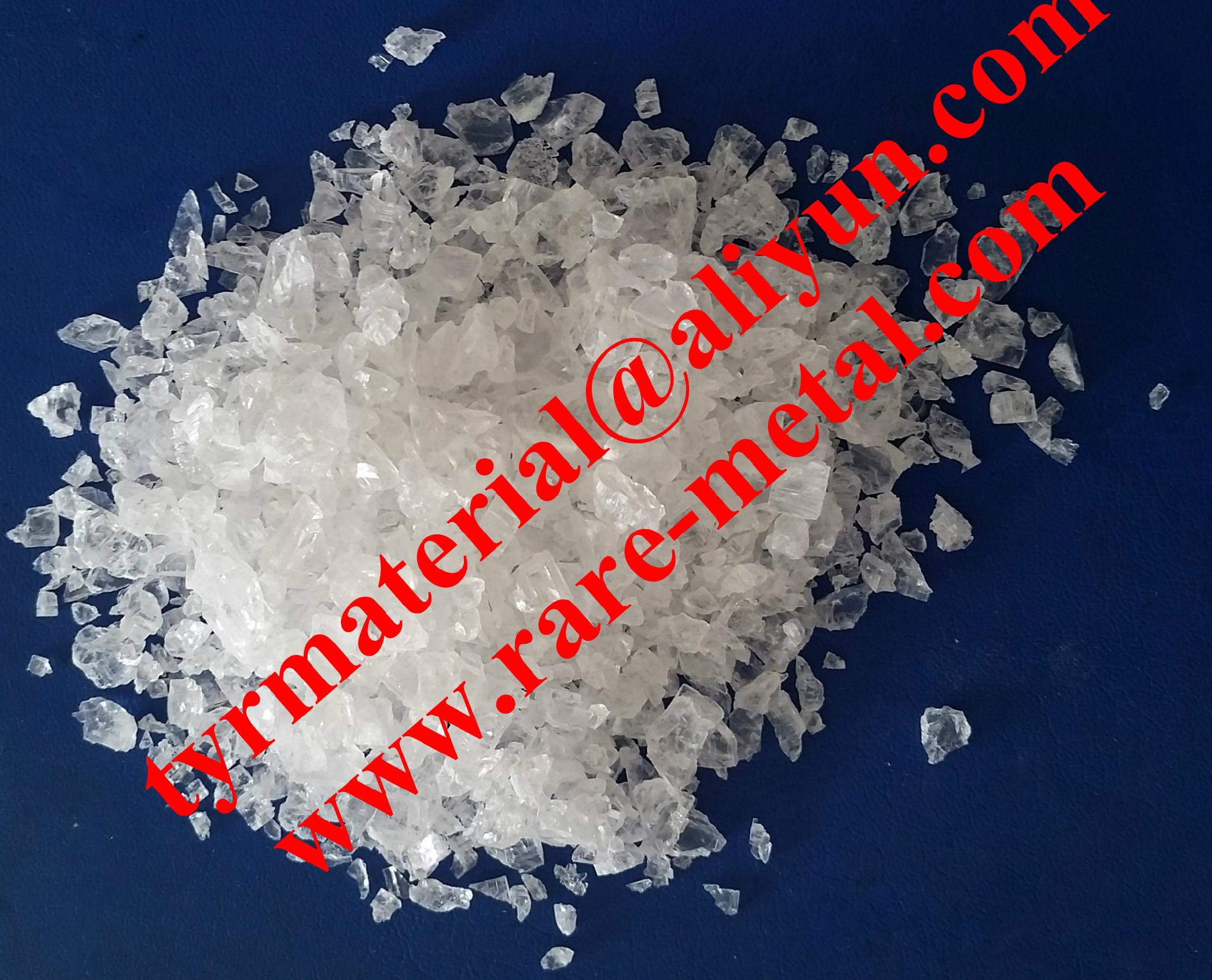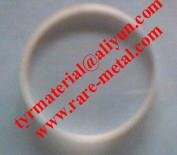Product Description
Lithium Fluoride, LiF optical crystal material from TYR as following:
Shape: shots,pellets,pieces,granules,rods,tablets
Spec.:
Tablets: 8mm dia. X 5mm L, 10mm dia. X 5mm L, 20mm dia. X 8mm L e.t.c
Pieces, Granules: 1-2.5mm, 3-6mm, 3-8mm, 1-3mm, 3-12mm e.t.c
1200 ℃ volatile), Density: 2.6350 g/cm3, Solubility (water) : Soluble in water, not soluble in alcohol,
dissolved in acid.
Applications: In molten salts, Optics, Radiation detectors, Nuclear reactors, Cathode for PLED and OLEDs
Fluorine is produced by the electrolysis of molten potassium bifluoride. This electrolysis proceeds more
efficiently when the electrolyte contains a few percent of LiF, possibly because it facilitates formation of
Li-C-F interface on the carbon electrodes.A useful molten salt, FLiNaK, consists of a mixture of LiF,
together with sodium fluoride and potassium fluoride. The primary coolant for the Molten-
Salt Reactor Experiment was FLiBe; LiF-BeF2 (66-33 mol%).
Because of its large band gap, LiF crystals are transparent to short wavelength ultraviolet radiation, more
so than any other material. LiF is therefore used in specialized UV optics, (See also magnesium fluoride).
Lithium fluoride is used also as crystal in X-ray spectrometry.
It is also used as a means to record ionizing radiation exposure from gamma rays, beta particles, and
neutrons (indirectly, using the Li (n,alpha) nuclear reaction) in thermoluminescent dosimeters.
Lithium fluoride (highly enriched in the common isotope lithium) forms the basic constituent of the
preferred fluoride salt mixture used in liquid-fluoride nuclear reactors.
Typically lithium fluoride is mixed with beryllium fluoride to form a base solvent (FLiBe), into which
fluorides of uranium and thorium are introduced. Lithium fluoride is exceptionally chemically stable and
LiF/BeF2 mixtures (FLiBe) have low melting points (360 C - 459 C) and the best neutronic properties of
fluoride salt combinations appropriate for reactor use. MSRE used two different mixtures in the two
cooling circuits.
Lithium fluoride is widely used in PLED and OLED as a coupling layer to enhance electron injection.
The thickness of LiF layer is usually around 1 nm. The dielectric constant (or relative permittivity) of
LiF is 9.0
LiF crystal shows excellent transmittance in the VUV region. It is used for optical windows, prisms,
and lenses in the visible and infrared in 0.104 μm - 7 μm. LiF crystal is sensitive to thermal shock and
would be attacked by atmospheric moisture at 400°C. In addition irradiation produces color centers.
Modest precautions should be taken against moisture and high energy radiation damage. Besides LiF softens at 600°C and is slightly plastic that can be bent into radius plates. The material can be cleaved along (100) and less commonly (110). Although the optical characteristics are good, the structure is not perfect and cleavage is difficult. For good structure LiF is less commonly grown by the Kyropoulos technique (air-grown) specifically for monochromator plates. High quality LiF is usually grown by modified Bridgman technique. Maximum available size in diameters is about 115mm. LiF is slightly plastic and can be bent into radius plates.
LiF crystals have the following exceptional properties that make it a very important optics single crystal:
(1) High optical transmittance from the vacuum ultraviolet to the infrared spectrum region(0.12-6μm) and shows excellent transmittance in the VUV regions.
(2) Used for Optical prisms, lenses, wedges, windows, other optical components,and etc
Because of its particular lattice structure LiF can also be used as X-ray diffraction devices.
LiF Specifications:
We produce granules, prisms, lenses, wedges, windows and other optical components according to requested specifications and drawings.
Size: Diameter >60mm
Size tolerance: +/-0.1mm
Angle tolerance: +/- 10 arcand Specifications
|
Transmission Range (μm)
|
0.12 ~ 6
|
|
Refractive Index at 0.6 μm
|
1.39181
|
|
Reflection Loss at 0.6 μm
|
5.2% (2 surfaces)
|
|
Absorption Coefficient at 2.7μm (cm-1)
|
0.74×10-3
|
|
Transmission range (μm)
|
0.11~7.0
|
|
Density (g/cm3)
|
2.639
|
|
Melting Point (°C)
|
870
|
|
Molecular Weight
|
25.9394
|
|
Thermal Conductivity at 314K (Wm</-1K-1)
|
4.01
|
|
Thermal Expansion at 283K (K-1)
|
37×10-6
|
|
Knops Hardness
|
99.1–103kg/mm2
|
|
Specific Heat Capacity (J Kgm-1K-1)
|
1562
|
|
Elastic Coefficient
|
C11=112; C12=46; C44= 63.5
|
|
Apparent Elastic Limit
|
11.2 Mpa (1620 psi)
|
|
Poisson Ratio
|
0.326
|
|
Solubility in 100g water at 20°C (g)
|
0.27
|
|
Crystal orientation
|
(100)
|
|
Application
|
DUV, Vacuum UV
|
|
Wavelength (nm)
|
150
|
193
|
248
|
308
|
400
|
600
|
800
|
|
Refractive index
|
1.4990
|
1.4477
|
1.4182
|
1.4083
|
1.3992
|
1.3918
|
1.3889
|
|
Wavelength (nm)
|
1000
|
2000
|
3000
|
4000
|
5000
|
6000
|
7000
|
|
Refractive index
|
1.3871
|
1.3787
|
1.3666
|
1.3494
|
1.3266
|
1.2974
|
1.2556
|
We also supply below material:
| Material Name |
Formula |
Purity |
Form |
| Aluminum Fluoride |
AlF3 |
99.9% |
Ceramic, Crystal |
| Magnesium Fluoride |
MgF2 |
99.99% |
Crystal |
| Barium Fluoride |
BaF2 |
99.99% |
Ceramic, Crystal |
| Lithium Fluoride |
LiF |
99.99% |
Crystal |
| Sodium Fluoride |
NaF |
99.9% |
Ceramic, Crystal |
| Strontium Fluoride |
SrF2 |
99.9% |
Ceramic |
| Material Name |
Formula |
Purity |
Form |
| Aluminum Fluoride |
AlF3 |
99.9% |
Ceramic, Crystal |
| Magnesium Fluoride |
MgF2 |
99.99% |
Crystal |
| Barium Fluoride |
BaF2 |
99.99% |
Ceramic, Crystal |
| Lithium Fluoride |
LiF |
99.99% |
Crystal |
| Sodium Fluoride |
NaF |
99.9% |
Ceramic, Crystal |
| Strontium Fluoride |
SrF2 |
99.9% |
Ceramic |
specification︰
Shape: shots,pellets,pieces,granules,rods,tablets
Spec.:
Tablets: 8mm dia. X 5mm L, 10mm dia. X 5mm L, 20mm dia. X 8mm L e.t.c
Pieces, Granules: 1-2.5mm, 3-6mm, 3-8mm, 1-3mm, 3-12mm e.t.c
Label︰
Lithium Fluoride (LiF) optical thin film coating material,
Product Image




